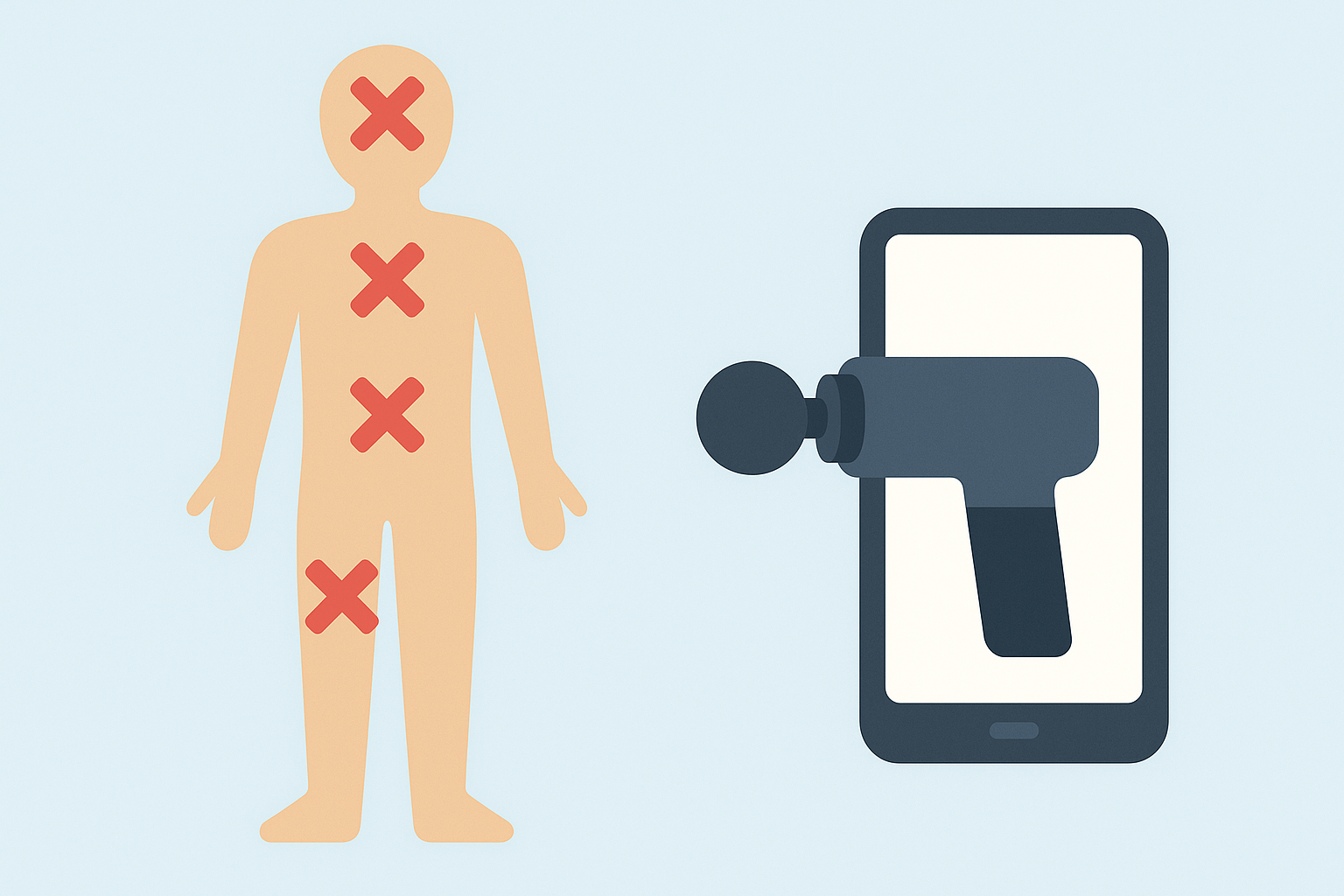Massage guns are excellent tools for relieving muscle tension, improving circulation, and speeding up recovery but they’re not meant to be used everywhere on the body. While these devices can provide deep relief when used correctly, applying them to the wrong areas can cause irritation, bruising, or even injury.
So, where should you avoid using a massage gun, and why? In this article, we’ll explain which areas of the body are too sensitive for percussion therapy, what risks are involved, and how to use your device safely for maximum results without harming yourself.
Why are some areas of the body unsafe for massage gun use?
Massage guns are designed to relieve muscle tension, enhance circulation, and support recovery, but not every part of the body is suitable for percussive therapy. While these devices are powerful and effective, certain areas are simply too delicate, too close to vital structures, or lack sufficient muscle tissue to safely absorb the intense vibrations. Understanding why some areas of the body are unsafe for massage gun use is essential to prevent injury and use the device safely and effectively.
The importance of muscle protection
A massage gun works by delivering rapid, repetitive pulses of pressure that penetrate deep into the soft tissues. This technique, known as percussion therapy, targets large muscle groups such as the quads, hamstrings, back, and shoulders. These areas can safely handle percussive force because they have thick layers of muscle that act as natural protection.
However, some regions of the body particularly those with thin muscle coverage or exposed bone lack that protective barrier. When the massage gun is applied directly over these areas, the force is transmitted to bones, joints, nerves, or blood vessels instead of being absorbed by muscle tissue. This can lead to pain, bruising, or even more serious complications if used repeatedly.
Sensitive areas with vital structures
The neck and spine are two of the most sensitive areas that require extra caution. The neck, for instance, contains major arteries (like the carotid artery) and delicate nerves that control movement and sensation. Using a massage gun here with excessive pressure or on the front of the neck can disturb blood flow or irritate nerves, potentially causing dizziness or numbness.
The spine is another area to avoid direct contact. The vertebrae are close to the surface and surrounded by ligaments rather than thick muscle tissue. Applying percussive force on the spine can cause discomfort or damage to nearby joints and tissues. Instead, it’s safer to use the device on the muscles alongside the spine such as the erector spinae rather than on the bones themselves.
Similarly, the front of the chest should be treated carefully. This area protects vital organs, including the heart and lungs, which are only separated from the skin by ribs and thin layers of muscle. Percussion therapy applied here could cause irritation or strain to the intercostal muscles or even affect breathing if used with too much pressure.
Joints, bones, and tendons
Another reason some body areas are unsafe for massage gun use is that they consist mainly of joints, bones, or tendons rather than muscle tissue. The knees, elbows, and ankles, for example, are primarily composed of ligaments and connective tissue. Applying percussive force here doesn’t release tension it instead stresses these structures and may cause inflammation or discomfort.
The same applies to bony areas such as the shins, collarbones, and ribs. Because these regions don’t have sufficient padding, the vibration from a massage gun can easily bruise the periosteum (the thin membrane covering bones) or irritate surrounding tissues.
Areas with poor circulation or medical concerns
Some areas are unsafe not because of their anatomy, but because of underlying health conditions. If you have varicose veins, blood clots, or vascular issues, using a massage gun can worsen the condition by disrupting blood flow. People with nerve damage, diabetes, or recent injuries should also avoid using massage guns on affected areas, as the reduced sensation may prevent them from realising when too much pressure is applied.
It’s also unsafe to use a massage gun near open wounds, bruises, or inflamed tissues, as this can increase pain and slow the healing process. In these cases, gentle stretching or manual massage is a safer alternative until the area has recovered.
Why proper technique matters
Even when used on safe muscle groups, poor technique can make otherwise safe areas unsafe. Applying excessive pressure, holding the device in one spot for too long, or using high speed settings can cause irritation, bruising, and soreness. The goal of percussion therapy is to stimulate, not to pound the muscles.
To stay safe, always keep the device moving slowly over the muscle surface, use moderate pressure, and limit sessions to 30 seconds to two minutes per muscle group.
Which areas should you never use a massage gun on?
Massage guns are excellent for easing tension, improving circulation, and speeding up recovery but they are not suitable for every part of the body. Because these devices use strong vibrations and percussive force, applying them to certain areas can lead to irritation, bruising, or even injury. Knowing which areas to avoid ensures you enjoy the benefits of percussion therapy safely and effectively.
Some parts of the body are too delicate, too close to vital organs, or lack the necessary muscle mass to absorb vibration safely. Using a massage gun on these regions can overstimulate nerves, damage tissue, or affect blood flow. Below are the key areas that should always be avoided during use.
The neck and throat are among the most sensitive areas of the body. The neck contains major arteries such as the carotid artery, along with nerves and ligaments that are not protected by thick muscles. The throat also includes delicate structures like the trachea and vocal cords that can be easily irritated by vibration. Using a massage gun here could cause dizziness, nerve sensitivity, or circulatory issues.
-
Avoid the front of the neck and throat, as direct pressure can disrupt blood flow and breathing.
-
If you wish to target neck tension, focus instead on the sides of the neck or the upper trapezius muscles, using light pressure and a low speed setting.
The spine and lower back joints should never be massaged directly with a gun. The spine consists of vertebrae and connective tissues with very little muscle protection, making it highly sensitive to percussive force. Using the device here can cause irritation, joint discomfort, or even inflammation of the spinal discs.
-
Avoid applying the massage gun directly over the spine or bony ridges.
-
Instead, work on the muscles alongside the spine, such as the erector spinae, which safely support back tension relief.
Bony areas and joints are also unsuitable for massage gun use. These parts of the body including elbows, knees, and ankles have minimal soft tissue to cushion the vibration. Direct application here can cause bruising, inflammation, or pain.
-
Avoid bony surfaces like the kneecaps, shins, collarbones, and ribs, which can bruise easily.
-
Stay away from joints such as the elbows, wrists, and knees, where tendons and ligaments are exposed.
The abdomen and chest should be treated with extreme caution. These areas cover vital organs like the heart, lungs, and digestive system, which are not meant to handle percussive force. Even light pressure could cause discomfort or internal irritation.
-
Avoid the stomach, ribs, and sternum, as these areas lack muscular protection.
-
Never use the massage gun near the heart, especially if you have heart disease or circulation problems.
The front of the hips and groin are other areas to avoid. These regions contain sensitive blood vessels, lymph nodes, and nerves that can easily be irritated or damaged. Using a massage gun here may lead to numbness, bruising, or circulatory issues.
-
Avoid the inner thighs and groin region, where vital arteries such as the femoral artery are located.
-
For hip relief, focus instead on the outer glutes and hip muscles, where the tissue is thicker and safer to target.
Lastly, a massage gun should never be used on injured, swollen, or bruised areas. Vibrations can worsen inflammation, increase pain, and delay healing. The same applies to areas affected by varicose veins, open wounds, or recent surgery.
-
Do not use a massage gun on injured or healing tissues, as this can aggravate the condition.
-
Avoid areas with skin conditions or sensitivity, such as eczema or recent bruises.
Using a massage gun safely means respecting your body’s limits and anatomy. Always stick to large, muscular regions like the thighs, calves, glutes, and upper back, where the tissue is strong enough to absorb vibrations without harm.
In summary, you should never use a massage gun on the neck, throat, spine, joints, abdomen, groin, or any injured area. These regions are too delicate for percussion therapy and can easily be damaged by intense vibrations. Focusing on well-padded muscle groups allows you to enjoy all the benefits of your device relaxation, recovery, and improved performance without putting your body at risk.
What are the safest areas to use a massage gun on?
A massage gun can be an incredibly effective recovery tool when used on the right areas. While some parts of the body are too delicate for percussive therapy, others are perfectly suited for it. The safest areas to use a massage gun are those with thick muscle mass capable of absorbing vibration without putting joints, bones, or nerves at risk.
The shoulders and upper back are among the safest zones for percussion therapy. Muscles like the trapezius and rhomboids often carry tension from stress or poor posture, and a massage gun can help loosen them effectively. Using slow, controlled movements for about one minute per side promotes relaxation and relieves stiffness.
The thighs and hamstrings are also ideal. These large muscle groups the quadriceps at the front and the hamstrings at the back can handle deeper vibration, making them perfect for pre-workout warm-ups or post-training recovery. The percussive motion improves blood flow, reduces fatigue, and speeds up muscle repair.
Similarly, the glutes and calves are excellent areas to target. The gluteal muscles are thick and often prone to tension from sitting or exercise, while the calves benefit from improved circulation and reduced tightness after long periods of standing or walking.
The arms, particularly the biceps and triceps, are also safe for light to moderate use. Just avoid pressing on the elbow joint or directly over the bone.
In general, the safest areas for using a massage gun are large muscle groups with plenty of soft tissue, such as the thighs, calves, glutes, shoulders, and upper back. Always use slow, gentle motions and moderate pressure for best results.



Can a massage gun help with neck pain?
How to correctly use a massage gun?